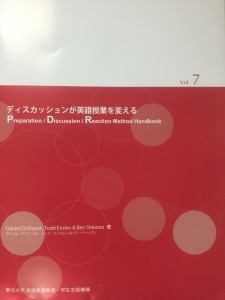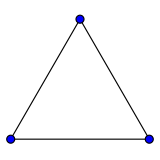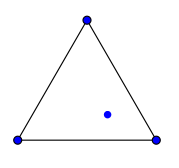Preparation Discussion Reaction: The PDR Method
How to get students speaking, discussing, and writing about real topics
Almost two years after it was first published, the PDR Handbook is finally available online.
PDR is a groundbreaking method for running 4-skills language classes for intermediate and above students. It can also be adapted for use with content classes. I have also used it successfully for teacher workshops.
You can download a copy of the Handbook in PDF format from here.
Academy curriculum extensive reading goals high school junior high school language courses school management
by sendaiben
4 comments
Cambridge Academy: Year Three Student Progress
Encouraging developments
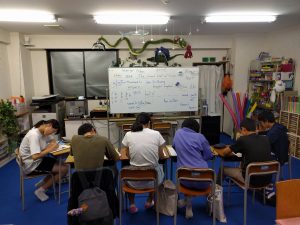
Second-year junior high school students in the output class
You can read previous Academy posts here:
- Extensive Reading for Secondary Students (April 2015)
- Six Months In (September 2015)
- Year One (February 2016)
- Looking at Year Two (March 2016)
- Stocktake (March 2016)
- Shadoku explained (April 2016)
- Some improvements to the curriculum (April 2016)
- December 2016 update (December 2016)
- Cambridge Academy: Year Two and Three (March 2017)
- Cambridge Academy: Stocktake 2017 (March 2017)
- Cambridge Academy: Another Quantum Leap (April 2017)
- Cambridge Academy: Year Three Mid-Year Update (August 2017)
The Academy is still going well. I’m having a lot of fun and I think at least some of the students are enjoying it too 😉
We lost one more student on average (lost three, gained two), but I think this is normal and it isn’t something that worries me. The students who are leaving tend to be our older students who started before the Academy existed and haven’t benefited as much as our newer students will from improved lessons and system. Here are our latest numbers:
Right now we have 78 students:
- 32 junior high school first years (29 regular, 2 reading only, 1 advanced)
- 21 junior high school second years (15 regular, 4 reading only, 2 advanced)
- 8 junior high school third years (5 regular, 3 reading only)
- 7 senior high school first years (4 regular, 3 reading only)
- 6 senior high school second years (5 regular, 1 reading only)
- 2 senior high school third years (2 regular)
- 2 ronin students (1 regular, 1 reading only)
It looks like we’re going to fill our first year output classes, as one student has changed to output after a few months of tutoring, and a trial student last week is going to try to do the same.
Today I’m going to share the students’ reading numbers. This gives some idea of how much our students are reading given an hour in class (probably more like 50-55 minutes) and for a few of them also reading at home. All numbers are up to date as of today.
First year (six months or so): 16,885-111,509 (most students are in the 30,000-50,000 range), YL0.2-0.4
Second year (eighteen months or so): 75,850-354,976 (most students are in the 120,000-160,000 range), YL0.3-0.6
Third year (thirty months or so): 197,892-748,564 (most students are around 300,000), YL0.6-4.0
You can’t really tell from the numbers above, but each year is reading more/better/faster than the years above them. Our current first years seem to be doing much better than our current second years did in their first year, who did better than our current third years did in their first year. I predict our current first years will be hitting 500,000 words by the end of junior high school, which should set them up to read a couple of million by the time they finish high school.
We need to continue buying intermediate books, and I am working on that. I am trying to find more leveled readers and books aimed at native speakers rather than graded readers (which tend to be a bit more dry). We already have mostly graded readers anyway. Students who find a series they like (Magic Tree House is very popular) and then read all the books in the series tend to do very well in terms of motivation and reading progress.
I have pretty much decided not to increase class sizes above ten, mostly due to the physical constraints of our current classrooms. I think we could do twelve easily, and probably up to twenty, but we just don’t have the room.
In terms of who will teach the classes, I am hoping to assign a teacher to each class next year. I will then join certain classes to model, observe, give feedback, etc. This should allow me to develop the system and get more of a birds’ eye view. Eventually it should allow me to take a step back with regards to the actual teaching too (and maybe open another school, but that’s a different blog post).
What do you think? What are your students’ numbers like? Any good intermediate books/series I could get?
curriculum junior high school language courses materials publishing
by sendaiben
2 comments
Three Types of Teachers
Perhaps more like three tendencies of teachers
I’ve been thinking about teachers a lot recently, and my own teaching experiences.
I’m starting to believe that there are three teachers archetypes. Few teachers will embody just one of them, but rather will be a mix of the three in different proportions. Maybe something like the introversion-extroversion scale.
So I believe there are ineffective teachers, individual-focused teachers, and system-focused teachers. Each of the points of the triangle above could be labeled with one of these, and all teachers could be shown as a dot inside the triangle.
In my experience most teachers (whether they are effective or not) tend to be individual-focused. They tend to think about the learner or relationships with learners. A few teachers are system-focused. They tend to think about curricula or classroom management.
The best teachers, the most inspirational, the ones that change lives, are highly effective individual-focused teachers.
The teachers that impact the biggest number of learners are highly effective system-focused teachers.
If I had to put myself on the triangle, I’d probably put myself here:
(the top point is individual-focused, the left ineffective, and the right system-focused)
After 17 years as a teacher I like to think I have become more effective, and I have definitely been drifting down and to the right recently.
I’ve been lucky to work with a highly effective system-focused teacher, Dan E., for the last few years. I’ve learned a huge amount from him and am still in awe of his skills and experience.
We’re currently working on a new project for junior high school students that is the most exciting thing I have ever done. I’ll be writing about it more as we get closer to completion.
So what do you think? Have you noticed the three types of teachers? Where would you put yourself in the triangle?
Academy business curriculum extensive reading high school JHS junior high school language courses Language learning school management SHS
by sendaiben
6 comments
Cambridge Academy: December 2016 Update
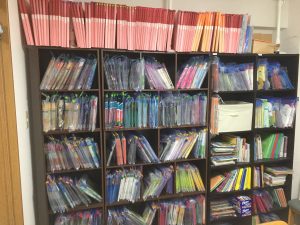
Academy beginner book section (YL0.1-0.7)
You can read about the Cambridge Academy in previous posts:
- Extensive Reading for Secondary Students (April 2015)
- Six Months In (September 2015)
- Year One (February 2016)
- Looking at Year Two (March 2016)
- Stocktake (March 2016)
- Shadoku explained (April 2016)
- Some improvements to the curriculum (April 2016)
Well, a lot has happened since my last post about the Academy (July 2016). We have had several schools visit, and I have talked to lots of people, and I have realised that in order for someone to start a program like the Academy in a school, the following four conditions are necessary:
- the desire and autonomy to begin a program
- the knowledge of ER to explain it to teachers, parents, and students
- a critical number of junior and senior high school students
- a large amount of money for books
So far I haven’t talked to anyone with all four of these, so we are putting our plans to license our system on hold. After all, if there are no potential customers it doesn’t make much sense to develop a product, right?
I’m still very happy to answer questions and give what advice I can though -feel free to leave a comment on this post or drop me an email.
Progress Report
We’re approaching Year Three for the Academy, and a lot is going well, and some things are going less well. We haven’t seen the growth I was hoping for (100 students are still out of reach), but we have a solid 70-some and next year is looking somewhat hopeful to break three figures.
1. Shadoku/Students that didn’t do shadoku last year
Our new first year reading curriculum incorporating shadoku is working extremely well. This year’s first year students are possibly doing better than last years’ (who are now second years). The second years are struggling a bit and I am trying different things to help them out, including having them re-read at a much lower level, etc. Not sure if the situation can be fixed completely, but at least we’ll do better going forwards.
We’ve also bought a lot of new books, particularly at the intermediate and advanced levels. Still not enough, but much closer to being able to meet our students’ future needs.

Academy intermediate book section (YL0.8-2.9)
A few of our students are really taking off with their reading, breaking the YL2.0 barrier and becoming more independent and motivated readers. It’s wonderful to see.
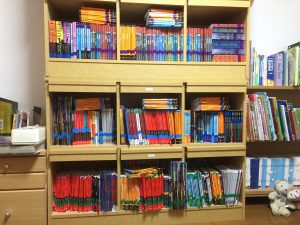
Academy advanced book section (YL3.0~)
I would say that somewhere over half our students are doing really well, and most of the others are doing okay. Maybe 20% are not doing well, and I hope some of them can be salvaged. Most of the ones who are not doing well started off badly, and I wasn’t skilled enough at the time to notice or help them.
2. Student reading targets
I’ve also noticed that students that read a certain amount are doing well, and those that read less are not. Using this data, I have come up with provisional weekly targets that we’ll start using next year with our students:
JHS1 2000-5000 words a week (100,000-250,000 words a year)
JHS2 3000-7000 words a week (150,000-350,000 words a year)
JHS3 4000-10000 words a week (200,000-500,000 words a year)
SHS1 4000-10000 words a week (200,000-500,000 words a year)
SHS2 5000-15000 words a week (250,000-750,000 words a year)
SHS3 6000-20000 words a week (300,000-1,000,000 words a year)
Based on these a student that joined our program in JHS1 and stayed with us until the end of high school would read 1,200,000 to 3,350,000 words. I predict this would provide them with some pretty decent English skills. The targets include in-class reading as well, so students with decent reading speeds might be able to clear the target just by reading in class for 55 minutes a week.
These numbers are provisional and we’ll probably adjust them after working with the students a bit next year. Looking at our current student data though, they seem reasonable. For comparison, in my university classes I require students to read 8,000 words a week to pass the course and 25,000 words a week to get a top grade.
3. Original junior high school output (speaking and writing) curriculum
We’re currently working on making our own curriculum for junior high school students for the output (speaking and writing) classes. As I mentioned in the improvements to curriculum post, the output classes have actually proven to be extremely important, and in the future we’ll be recommending students take both classes if at all possible.
Reading classes are much more profitable, but so far the results of students that only take reading are not satisfactory so we’ll have to abandon that idea as a profit centre 🙂
We should have the original curriculum for JHS1 ready to try from April, and then develop year two in 2017 and year three in 2018. Using the new curricula, we will now place junior high school students in their equivalent year class instead of trying to stream them by ability. High school students will be streamed by ability/level.
4. Assistant teachers
We have a couple of assistant teachers this year. They were students in the program last year, and are now attending local universities. We asked them to help us out as part-time staff.
The huge advantage of recruiting assistants like this is that they are very familiar with the system. It’s a win-win: we get dependable and skilled assistants that we know and trust, and they get to continue their English studies while doing fairly well-paid and interesting part-time work.
Best of all, this model should be fairly sustainable: I would expect we’ll have at least one suitable student per year graduating and we can keep them for four years while they are at university.
5. The next steps
Right now we need to do a few things before the end of the year. I would like to write a student guide to the curriculum that explains what they need to do. I think this will help students and their parents get more out of their classes.
We also need to buy some more books, although we can probably slow down a bit now.
Another stocktake will have to happen at the end of the year and book purchases to fill in holes.
We’re going to need more shelves soon too.
We’ll also be taking over another school and inviting their students to join our program from April. Hopefully this will build up our numbers a little bit.
All good stuff. I’m really looking forward to how the Academy develops as we go into our third year.
Anyone else working on extensive reading systems? Any questions or comments?
Extensive Reading Rant
My first video for the iTDI Making ELT Videos course
The second week assignment for the iTDI Making ELT Videos course was to make a video. Here’s my sad attempt 🙂
It was rushed, shot on two devices, edited with Windows Movie Maker (which in my opinion is complete garbage -need better software). No music, had real trouble putting the screenshots in (hence the messed up audio from halfway through), didn’t do proper lighting, forgot to add links and a call to action…
BUT, I learned a huge amount and had fun. Looking forward to doing a better job with the second one.
